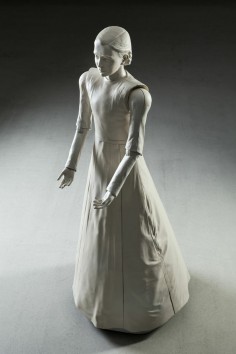Mari Velonaki
Diamandini
source: kathycleland
Diamandini is a 155cm tall custom-made humanoid robot incorporating an omni-directional wheeled motion platform; cameras, laser scanners and computers for real-time tracking and installation control. The humanoid robot is being developed through a five year research project between Mari Velonaki and robotics scientists at the Centre for Social Robotics, Australian Centre for Field Robotics, the University of Sydney. Diamandini will be making her first exhibition appearance in the Signs of Life exhibition as a work in progress.
Spectators enter an installation space where a kinetic sculpture is moving about in a smooth, choreographed manner. The kinetic sculpture is a robot that resembles a small-scale female figure that does not bear any elements that would classify her as a typical android robot. The texture that covers the robot from her head to the hem of her long dress is porcelain-like, and makes her look more like a floating figurine rather than a robot. Her movement is accompanied by soundscapes generated from within her. When a spectator approaches the figurine she responds physically by turning towards the person and gently moving closer to them.
This project aims to investigate intimate human-robot interactions in order to develop an understanding of the physicality that is possible and acceptable between a human and a robot. ‘Diamandini’ is an interactive autokinetic artwork that investigates the dialogical possibilities between a robot, in the form of female figurine, that can communicate with her audience through the modalities of movement and (at a later stage) written text. Spectators entering the installation space attract the attention of the robot; dialogues occur kinetically through the robot’s ‘perception’ of the body language of the participant, and as the participant reacts to the ‘body language’ of the robot.
.
.
.
.
.
.
.
source: factcouk
Diamandini is an interactive, auto-kinetic artwork that investigates the dialogical possibilities of a robot, in the form of female figurine that can communicate with her audience through movement.
.
.
.
.
.
.
.
source: robotronicaquteduau
Diamandini breaks the conventions of robotic design. A robot with a feminine touch, she appears like a floating classical sculpture as she intriguingly engages with audiences. Gracing historic Old Government House, watch as she reacts and responds to your movement and body language – as you enter her space, will she turn towards you or turn away? Diamandini is an interactive autokinetic sculpture that will change the way you think about robots.
Diamandini is a five year Australia Research Council project between artist Mari Velonaki and roboticists at the Centre for Social Robotics, Australian Centre for Field Robotics, the University of Sydney. This project aims to investigate human-robot interactions in order to develop an understanding of the physicality that is possible and acceptable between a human and a robot within a social space.
.
.
.
.
.
.
.
source: emol
Mari Velonaki y David Rye son los creadores de “Diamandini”, un androide de 1,55 metros de altura que ayudará a entender las interacciones entre robots y seres humanos en espacios sociales a través de sus movimientos, y en una etapa posterior mediante el contacto.
.
.
.
.
.
.
.
source: factcouk
Mari Velonaki has worked as an artist in the field of interactive installation art since 1997. She has created interactive installations that incorporate movement, speech, touch, breath and electrostatic charge. In 2003 Mari’s practice expanded to robotics, when she initiated and led a major Australian Research Council project, Fish–Bird 2004–2007, in collaboration with roboticists at the Australian Centre for Field Robotics.
In 2006 she co-founded, with David Rye, the Centre for Social Robotics, a centre dedicated to inter-disciplinary research. In 2007 Mari was awarded an Australia Council for the Arts Visual Arts Fellowship and in 2009 an Australia Research Council Queen Elizabeth II Fellowship (2009–13). Mari is currently an associate professor and the director of the Creative Robotics Lab at NIEA, COFA, UNSW. Mari’s work has been widely exhibited..
.
.
.
.
.
.
.
source: nieaunsweduau
Associate Professor Mari Velonaki has worked as an artist and researcher in the field of interactive installation art since 1995. Velonaki has created interactive installations that incorporate movement, speech, touch, breath, electrostatic charge, artificial vision and robotics. In 2003, Velonaki’s practice expanded to robotics, when she initiated and led a major Australian Research Council art/science research project “Fish-Bird: Autonomous Interactions in a Contemporary Arts Setting” in collaboration with robotics scientists at the Australian Centre for Field Robotics (ACFR, University of Sydney). In 2007, Velonaki was awarded an Australia Council for the Arts Visual Arts Fellowship, and in 2009 she was awarded an ARC Australian Research Fellowship.
In 2006, Velonaki co-founded, with Dr David Rye at the ACFR, the Centre for Social Robotics (CSR)—a centre dedicated to interdisciplinary research into human-robot interaction in spaces that incorporate the general public. Velonaki is also the Director of the recently established Creative Robotics Lab (CRL) at NIEA. The CRL provides a cross-disciplinary research environment dedicated to understanding how humans can interact with mechanical and robotic devices within the context of experimental arts and social robotics. Through her transdisciplinary artistic practice and research roles at UNSW and the University of Sydney, Velonaki has established valuable working partnerships with a number of internationally leading robotics, cognitive science and engineering scientists and institutions.


